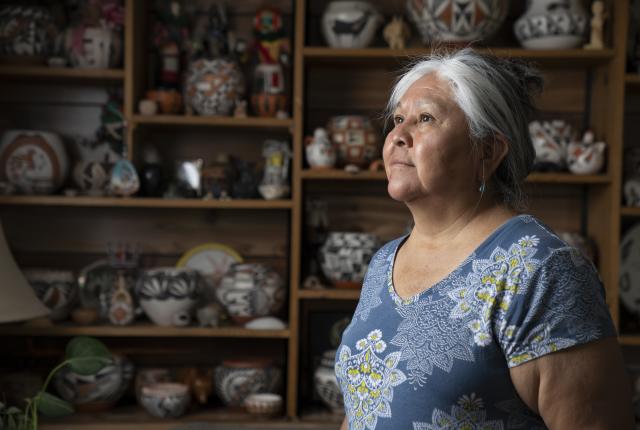This essay is one of 70 by mostly Pueblo people—artists, writers, historians, scientists, and political leaders—collected for "Grounded in Clay: The Spirit of Pueblo Pottery," an exhibition that runs through May 29, 2023, at the Museum of Indian Arts & Culture. For an insider's look at the exhibit, read "Pueblo Pottery Exhibit Breaks the Mold," by Kate Nelson.
WHEN I FIRST SAW this storage jar in the book Lucy M. Lewis: American Indian Potter, I was impressed by a spread featuring a close-up of the double-headed thunderbird. It is framed by a rainbow, and its simple elegance drew me in. When I saw the entire pot reproduced on the following page, I was overwhelmed by the design as a whole. Each feature contributes its own beauty and balance. I believe this is when I fell in love with the jar, but it would be many years before I attempted to paint this design. It comprises numerous elements, yet it still has breathing room and does not feel compressed or dense.
The designs are typical of Acoma pottery: There are animals (birds and deer); geometric shapes representing mountains; and plants and clouds (the curvilinear triangles, some split). The double-headed thunderbird, set within an unconventional squared, stepped rainbow, is especially alluring. One’s eye is drawn along the rainbow to the next feature, the deer. The shape of the deer’s antlers reminds me of the deer found in Zuni pottery. Stepped solid-black and hatched bands frame the geometric designs. They may be interpreted as a rainbow (the hatched lines indicate rainfall) and lightning (depicted by the black band). The elongated arches—which envelop “lobes” and a rectangular “eye,” and are edged with scalloped clouds—ground the flow of this design, along with the adjacent black-and-white parallelograms and triangles and stepped hatching. This feature ends with a solid triangle positioned above a rectangular bar, which possibly represent the land and mountains upon which the deer stands. The overall design reflects prayers for rain.
Attempts to scrape off painting mistakes are visible on the pot’s surface—for example, near the rump of the deer [not shown in this image]. These indicate that the potter painted entirely freehand rather than relying on a penciled outline. Since most of these older pots were used, such flaws would not have mattered to the potter because only the Creator is perfect. (One may see similar features in my own work!) The pot has yellowed in some areas and has two pine-pitch repairs. All these features only add to its beauty.
Feeling the interior of the jar, where the potter placed her fingers and hands while shaping this piece, connects me not only to her but also to our shared past—a living past that is my present and future. The use of ground sherds from older pots for the clay temper brings that past literally into our present, and when these pots are but pieces of the past, they too will carry on our pottery-making tradition. The creation of pottery with the same clay and methods used by our ancestors is the embodiment of our collective spirit. As my grandmother Lucy Lewis would say, “I mix my clay with me.” Each pot has our spirit in it, each has its own personality, and it is this, I believe, that draws others to it.
Read More: Don't miss essays by Diego Medina, Evone “Snowflake” Martinez, Melissa Talachy Romero, Mateo Romero, and Dominique Toya.



